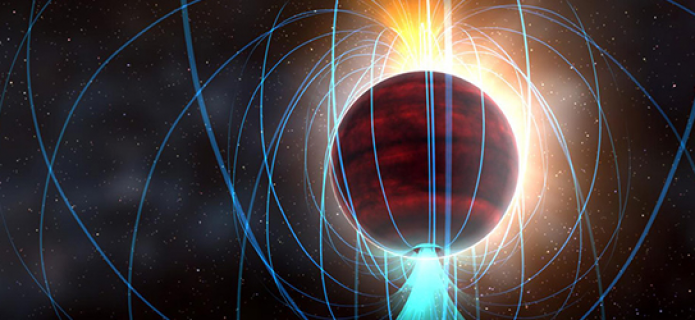Cool, Dim Dwarf Star is Magnetic Powerhouse
Astronomers using the Atacama Large Millimeter/submillimeter Array (ALMA) have discovered that a dim, cool dwarf star is generating a surprisingly powerful magnetic field, one that rivals the most intense magnetic regions of our own Sun.
The star’s extraordinary magnetic field is potentially associated with a constant flurry of solar-flare-like eruptions. As with our Sun, these flares would trace tightly wound magnetic field lines that act like cosmic particle accelerators: warping the path of electrons and causing them to emit telltale radio signals that can be detected with ALMA.
Such intense flare activity, the astronomers note, would barrage nearby planets with charged particles.
Animation of artist impression of red dwarf star TVLM 513-46546. ALMA observations suggest that it has an amazingly powerful magnetic field, potentially associated with a flurry of solar-flare-like eruptions. Credit: NRAO/AUI/NSF; Dana Berry / SkyWorks
Animation of artist impression of red dwarf star TVLM 513-46546 without showing magnetic field lines. ALMA observations suggest that it has an amazingly powerful magnetic field, potentially associated with a flurry of solar-flare-like eruptions. Credit: NRAO/AUI/NSF; Dana Berry / SkyWorks
"If we lived around a star like this one, we wouldn’t have any satellite communications. In fact, it might be extremely difficult for life to evolve at all in such a stormy environment," says lead author Peter Williams of the Harvard-Smithsonian Center for Astrophysics (CfA) in Cambridge, Massachusetts.
The team used ALMA to study the well-known red dwarf star TVLM 513-46546, which is located about 35 light-years from Earth in the constellation Boötes.
The star is a mere 10 percent the mass of the Sun and is so small and cool that it's right on the dividing line between stars (which fuse hydrogen) and brown dwarfs (which don’t). One of the things that make this small star remarkable is that it spins rapidly, completing a full rotation about every two hours. Our Sun takes about 25 days to rotate once about its equator.
Previous data from the National Radio Astronomy Observatory’s Karl G. Jansky Very Large Array in Socorro, New Mexico, show that this star exhibits a magnetic field that rivals the Sun’s most extreme magnetic regions and is several hundred times stronger than the Sun's average magnetic field.
This puzzled astronomers because the physical processes that generate the Sun’s magnetic field shouldn’t operate in such a small star.
"This star is a very different beast from our Sun, magnetically speaking," states CfA astronomer and co-author Edo Berger.
When the researchers examined the star with ALMA they detected emission at a particularly high frequency (95 GHz or a wavelength of about 3 millimeters). Such a radio signal is produced by a process known as synchrotron emission, in which electrons zip around powerful magnetic field lines: the more powerful the magnetic field, the higher the frequency.
This is the first time that flare-like emission at such high frequencies has been detected from a red dwarf star. It is also the first time that such a star has been detected at millimeter wavelengths, opening up a new avenue of study with ALMA.
Our Sun generates similar emission from solar flares but only intermittently. What's more, the emission from this star is 10,000 times brighter than what our own Sun produces, even though it has less than one-tenth of the Sun's mass. The fact that ALMA detected this emission in a brief 4-hour observation suggests that the red dwarf is continuously active.

Artist impression of red dwarf star TVLM 513-46546. ALMA observations suggest that it has an amazingly powerful magnetic field, potentially associated with a flurry of solar-flare-like eruptions. Credit: Dana Berry (NRAO/AUI/NSF) / SkyWorks
This has important implications for the search for habitable planets outside the Solar system. Red dwarfs are the most common type of star in our Galaxy, which makes them promising targets for planet searches. But because a red dwarf is so cool, a planet would have to orbit very close to the star to be warm enough for liquid water to exist at its surface. That proximity would put the planet right in the bull's-eye for radiation that could strip its atmosphere or destroy any complex molecules on its surface, the astronomers speculate.
Astronomers will study similar stars in the future to determine whether this one is an oddball or an example of an entire class of stormy stars.
These findings have been accepted for publication in The Astrophysical Journal.
More information
The Atacama Large Millimeter/submillimeter Array (ALMA), an international astronomy facility, is a partnership of the European Organisation for Astronomical Research in the Southern Hemisphere (ESO), the U.S. National Science Foundation (NSF) and the National Institutes of Natural Sciences (NINS) of Japan in cooperation with the Republic of Chile. ALMA is funded by ESO on behalf of its Member States, by NSF in cooperation with the National Research Council of Canada (NRC) and the Ministry of Science and Technology (MOST) in Taiwan and by NINS in cooperation with the Academia Sinica (AS) in Taiwan and the Korea Astronomy and Space Science Institute (KASI).
ALMA construction and operations are led by ESO on behalf of its Member States; by the National Radio Astronomy Observatory (NRAO), managed by Associated Universities, Inc. (AUI), on behalf of North America; and by the National Astronomical Observatory of Japan (NAOJ) on behalf of East Asia. The Joint ALMA Observatory (JAO) provides the unified leadership and management of the construction, commissioning and operation of ALMA.
Links
Contacts:
Valeria Foncea
Education and Public Outreach Officer
Joint ALMA Observatory
Santiago, Chile
Tel: +56 2 467 6258
Cell: +56 9 75871963
E-mail: [email protected]
Charles E. Blue
Public Information Officer
National Radio Astronomy Observatory
Charlottesville, Virginia, USA
Tel: +1 434 296 0314
Cell: +1 434.242.9559
E-mail: [email protected]
Richard Hook
Public Information Officer, ESO
Garching bei München, Germany
Tel: +49 89 3200 6655
Cell: +49 151 1537 3591
E-mail: [email protected]
Masaaki Hiramatsu
Education and Public Outreach Officer, NAOJ Chile
Observatory
Tokyo, Japan
Tel: +81 422 34 3630
E-mail: [email protected]


